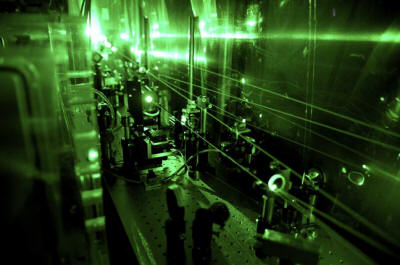|

by Clara Moskowitz
LiveScience Senior Writer
07 July 2010
from
LiveScience Website

This laser
apparatus used to test the size of the proton
found that the
particle's radius is about 4 percent smaller than thought.
Credit: F. Reiser and
A. Antognini, Paul-Scherrer-Institute
The proton, one of the most well-known
and basic building blocks of matter, turns out to be holding on to a
few secrets. A new measurement found that the radius of the proton
is about 4 percent smaller than previously thought.
Protons are positively charged elementary particles. Together with
neutrons and electrons, they make up the
atoms that build our
universe.
Scientists discovered the surprising anomaly by shooting laser beams
at an exotic version of a hydrogen atom, which most often consists
of one proton and one electron.
The new measurement has improved the
accuracy of the known
proton radius by a factor of ten, the
researchers said.
The finding means that either the theory governing how light and
matter interact (called quantum electrodynamics, or
QED) must be
revised, or that a constant used in many fundamental calculations is
wrong, the researchers said.
"The authors’ measurement uses a novel method that is more sensitive
than any of the earlier methods," wrote Jeff Flowers of the U.K.'s
National Physical Laboratory in an accompanying essay in the same
issue of Nature.
"But it gives a result that is significantly
discrepant from that obtained by the next most accurate method,
throwing doubt on the QED calculations that underlie both methods."
Flowers was not involved in the new measurement.
Exotic hydrogen
In the experiment, the researchers used a special version of
hydrogen that contains one proton and one muon - an
exotic cousin of
the electron that weighs about 200 times more than an electron.
The
muon, just like an electron, is a point-like particle that orbits
around the more extended proton.
"Think of the proton as a fuzzy cloud of charge," described the lead
researcher, Randolf Pohl of Germany's Max-Planck Institute of
Quantum Optics. "It's not a hard surface, not a ball."
In fact, the muon can even pass straight through the proton, which
contains lots of open space between its constituent building blocks
- three particles called
quarks.
The muon can exist in different energy states that affect the way it
orbits the proton. The size of the proton affects these states and
how much energy is required to knock a muon out of one and into
another.
And these effects are amplified by the larger mass of the muon
compared to an electron, allowing the researchers a chance to peer
into the orbital mechanics of the atom.
Blasting with lasers
To home in on the size of the proton, the scientists finely
tuned a laser beam to blast their hydrogen atoms with very specific amounts
of energy, hoping to stimulate the muons to jump from one energy
state to another.
For a long time, they observed no effect in the range they expected,
and assumed their laser was faulty.
Finally the researchers tried an
energy range completely removed from the expected region, and found
exactly the transition they were looking for.
"When it wasn't in the reasonable region, we extended our search
region to the unreasonable, and then we had this indication of a
signal," Pohl told LiveScience.
"We were really stunned."
If the new value is confirmed, it could mean some
rewriting of basic
physics is in order.
Perhaps the value of the so-called
Rydberg constant, which is used
to calculate the proton's size, is off. If that is the case, other
fundamental calculations will need revising, too.
Or, perhaps the entire theory describing this and other particles -
quantum electrodynamics - is misunderstood.
"If experimental discrepancies are
confirmed rather than errors being found, high-accuracy work
such as that by Pohl and colleagues, not the high-energy
collisions of giant accelerators, may have seen beyond the
standard model of particle physics," Flowers wrote.
|

